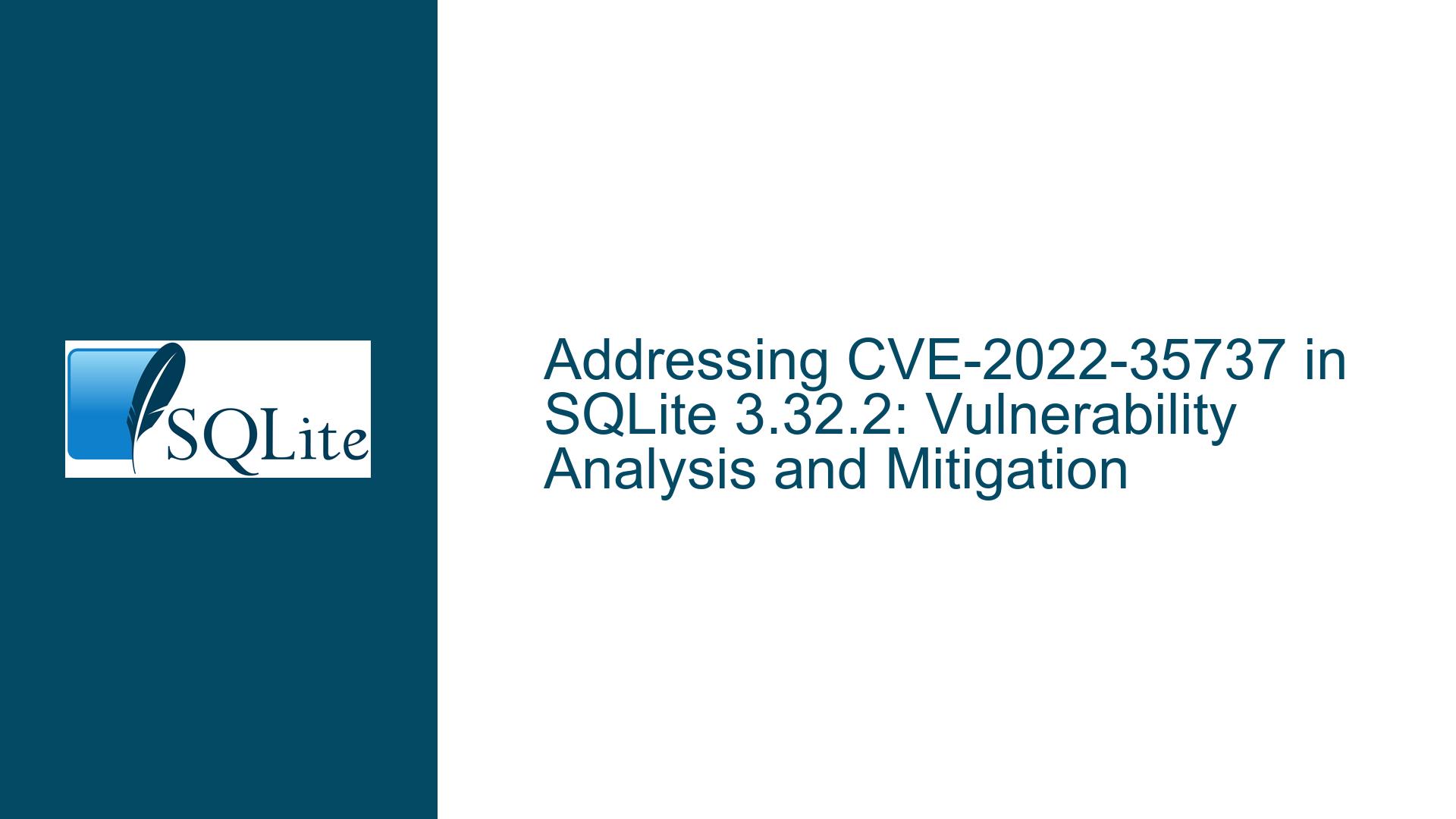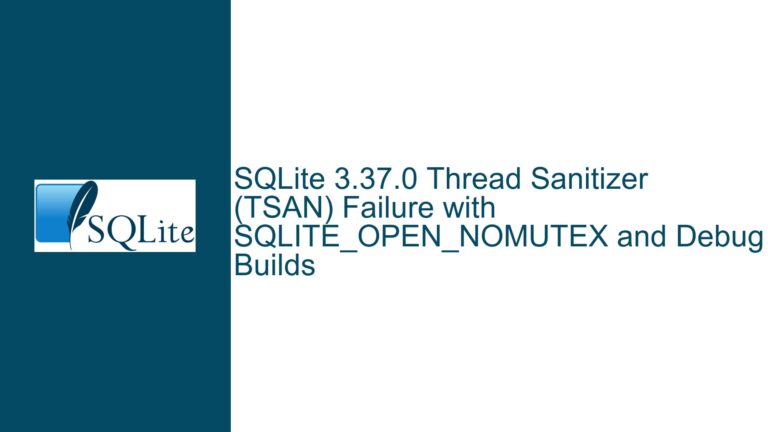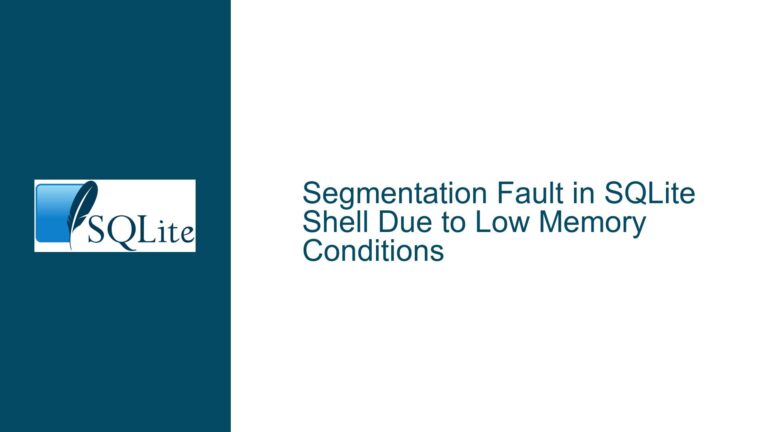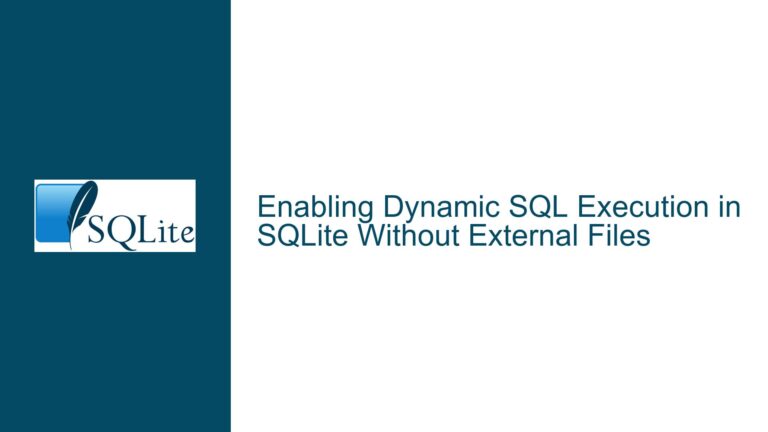Addressing CVE-2022-35737 in SQLite 3.32.2: Vulnerability Analysis and Mitigation
Understanding the CVE-2022-35737 Vulnerability in SQLite
CVE-2022-35737 is a critical vulnerability identified in SQLite versions 1.0.12 through 3.39.x, specifically before version 3.39.2. The vulnerability arises from an array-bounds overflow that can occur when processing extremely large string arguments passed to certain C APIs. This overflow can lead to undefined behavior, including potential memory corruption, crashes, or even arbitrary code execution under specific conditions. The vulnerability is particularly concerning because it affects a wide range of SQLite versions, including older releases that are still in use in many systems.
The core issue lies in how SQLite handles string arguments in its C API. When a string of billions of bytes is passed to specific functions, the internal buffer management fails to properly validate the size of the input, leading to an overflow. This overflow can corrupt adjacent memory regions, potentially compromising the stability and security of the application using SQLite. The vulnerability was addressed in SQLite 3.39.2, but for users who cannot upgrade to this version, understanding the root cause and implementing workarounds is essential.
Root Causes of the Array-Bounds Overflow in SQLite
The array-bounds overflow in CVE-2022-35737 stems from insufficient validation of string lengths in SQLite’s C API functions. SQLite, being a lightweight and embedded database, is designed to handle a wide range of data sizes efficiently. However, this efficiency sometimes comes at the cost of rigorous input validation, especially for edge cases involving extremely large inputs. In this case, the vulnerability occurs because SQLite does not enforce strict bounds checking when processing strings that exceed the expected size limits.
The specific functions affected by this vulnerability are those that accept string arguments and perform operations such as copying, concatenation, or formatting. When these functions receive a string that is billions of bytes long, the internal buffer allocated for processing the string may not be large enough to accommodate the input. This results in an overflow, where data is written beyond the allocated buffer, corrupting adjacent memory regions. The lack of proper bounds checking in these functions is the primary cause of the vulnerability.
Another contributing factor is the historical design philosophy of SQLite, which prioritizes performance and minimalism over exhaustive error checking. While this approach has made SQLite one of the most widely used databases, it also means that certain edge cases, such as extremely large inputs, may not be handled as robustly as in more heavyweight databases. This vulnerability highlights the importance of balancing performance with security, especially in widely deployed software like SQLite.
Mitigating CVE-2022-35737 in SQLite 3.32.2
For users who cannot upgrade to SQLite 3.39.2, mitigating CVE-2022-35737 requires a combination of code modifications, runtime checks, and operational safeguards. The following steps outline a comprehensive approach to addressing the vulnerability in SQLite 3.32.2:
Implement Input Validation in Application Code: Since the vulnerability arises from passing excessively large strings to SQLite’s C API, one of the most effective mitigations is to enforce strict input validation in the application code. Before passing any string to SQLite, the application should verify that the string length is within reasonable limits. For example, if the application expects strings to be no longer than a few kilobytes, it should reject any input that exceeds this threshold. This approach prevents the vulnerable SQLite functions from being called with oversized inputs, effectively mitigating the risk of an overflow.
Patch SQLite Source Code: If modifying the application code is not feasible, another option is to patch the SQLite source code directly. The fix for CVE-2022-35737 involves adding bounds checking to the affected C API functions. By examining the changes made in SQLite 3.39.2, users can backport these fixes to earlier versions, such as 3.32.2. This requires identifying the specific functions that handle string processing and adding checks to ensure that the input size does not exceed the allocated buffer size. While this approach requires a deeper understanding of SQLite’s internals, it provides a more robust solution than application-level mitigations.
Use Runtime Sanitizers and Memory Checkers: Another layer of defense is to use runtime tools that can detect and prevent memory corruption. Tools such as AddressSanitizer (ASan) and Valgrind can be integrated into the application to monitor memory usage and identify potential overflows. These tools work by instrumenting the application’s memory accesses and flagging any operations that violate memory safety. While they may introduce some performance overhead, they provide valuable insights into the application’s behavior and can help catch vulnerabilities before they are exploited.
Limit SQLite’s Exposure to Untrusted Inputs: In scenarios where SQLite is used in a multi-user or networked environment, it is crucial to limit its exposure to untrusted inputs. This can be achieved by implementing strict access controls and input sanitization at the application level. For example, if SQLite is used as the backend for a web application, the application should validate and sanitize all user inputs before passing them to SQLite. Additionally, using prepared statements and parameterized queries can help prevent SQL injection attacks and reduce the risk of passing malicious inputs to SQLite.
Monitor and Update Dependencies: While upgrading to SQLite 3.39.2 is the most straightforward solution, it may not always be possible due to compatibility or operational constraints. In such cases, it is essential to monitor the SQLite project for updates and security patches. Regularly reviewing the SQLite changelog and CVE database can help identify new vulnerabilities and assess their impact on the current deployment. If a critical vulnerability is discovered, it may be necessary to revisit the decision to stay on an older version and prioritize upgrading to a secure release.
Conduct Security Audits and Penetration Testing: Finally, conducting regular security audits and penetration testing can help identify and address vulnerabilities in the application and its dependencies. These assessments should include a thorough review of how SQLite is used in the application, focusing on areas where untrusted inputs are processed. By simulating real-world attack scenarios, security teams can uncover potential weaknesses and implement appropriate mitigations before they are exploited.
In conclusion, CVE-2022-35737 is a serious vulnerability that requires careful attention, especially for users of older SQLite versions. By understanding the root causes and implementing a combination of code modifications, runtime checks, and operational safeguards, it is possible to mitigate the risk and maintain the security and stability of the application. While upgrading to SQLite 3.39.2 is the recommended solution, the steps outlined above provide a comprehensive approach to addressing the vulnerability in environments where upgrading is not immediately feasible.






